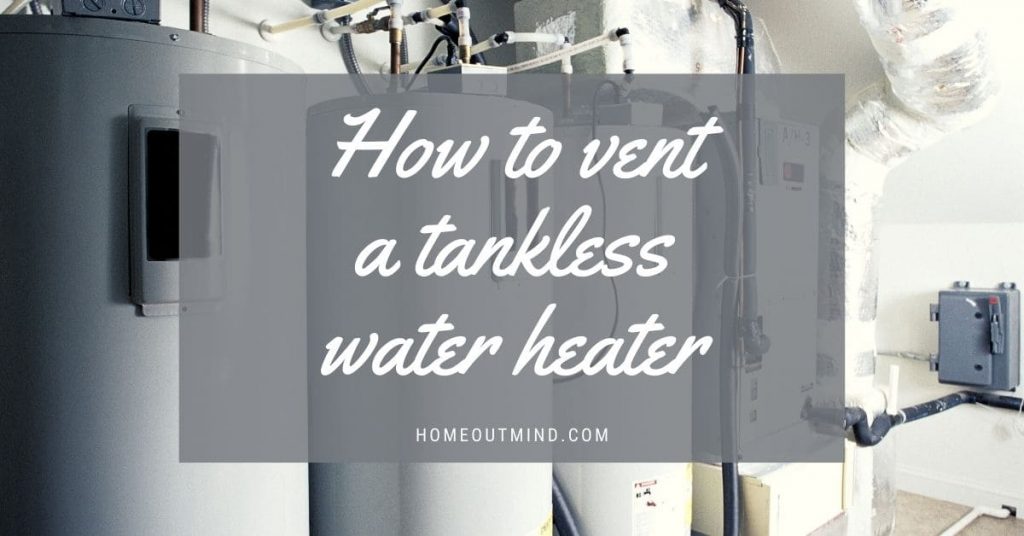Venting a tankless water heater is a critical aspect of its installation process, ensuring both safety and efficiency in its operation. Proper ventilation allows for the safe expulsion of combustion byproducts, such as carbon monoxide, while also optimizing the heater’s performance.
In this guide, we will provide a comprehensive step-by-step approach to venting a tankless water heater, covering essential considerations, materials, and installation techniques to ensure a successful and compliant venting system.

Step 1. Understand Venting Requirements
Before you start the installation process, it’s essential to understand the venting requirements specific to your tankless water heater model.
Refer to the manufacturer’s instructions and local building codes to determine the appropriate venting materials, sizes, and configurations needed for your installation.
Step 2. Choose the Right Venting System
Tankless water heaters can be vented using either a direct vent system or a non-direct vent system.
- Direct vent systems use a sealed combustion chamber and draw air from outside the home for combustion, while non-direct vent systems rely on indoor air for combustion.
- Select the venting system that best suits your heater’s location and your home’s layout.
Step 3. Plan the Venting Route
Carefully plan the venting route to ensure proper airflow and compliance with local building codes.
The venting system should be as short and straight as possible with minimal bends or obstructions.
Avoid running the vent near windows, doors, or other areas where exhaust gases could re-enter the home.
Step 4. Gather Venting Materials
Once you’ve determined the venting route, gather all the necessary venting materials, including vent pipes, elbows, connectors, termination kits, and sealing components.
- Choose high-quality venting materials that are suitable for use with your tankless water heater and compatible with the fuel type (natural gas, propane, etc.).
Step 5. Install the Vent Pipes
Begin by assembling the vent pipes according to the manufacturer’s instructions, ensuring a secure and airtight connection at each joint.
- Use appropriate sealing materials, such as high-temperature silicone sealant or metal tape, to prevent leaks.
- Install any required elbows or connectors to navigate around obstacles and maintain proper clearances.
Step 6. Vent Termination
Proper vent termination is critical to prevent backdrafting and ensure the safe expulsion of combustion byproducts.
- Install a termination kit at the end of the vent pipe according to the manufacturer’s instructions.
- Position the termination outlet away from windows, doors, and air intakes, and ensure adequate clearance from nearby structures or obstructions.
Step 7. Conduct a Venting Test
Once the venting system is installed, perform a thorough inspection to check for any leaks, damage, or improper connections.
- Conduct a venting test by running the tankless water heater and verifying that exhaust gases are safely vented outside.
- Monitor the venting system during operation to ensure proper airflow and combustion.
Step 8. Regular Maintenance
Lastly, schedule regular maintenance checks to inspect the venting system for any signs of damage, corrosion, or blockages.
Clean or replace venting components as needed to maintain optimal performance and safety.
Additionally, install carbon monoxide detectors near the water heater and throughout your home for added safety.
Do tankless water heaters require special venting?
Yes, tankless water heaters often require special venting to ensure safe operation and proper ventilation of combustion byproducts.
The venting system must be designed to accommodate the high-efficiency combustion process of tankless heaters and comply with manufacturer specifications and local building codes.
Where do you put the vent on a tankless water heater?
The vent on a tankless water heater is typically installed at the top of the unit, allowing for the safe expulsion of combustion byproducts outside the home.
The precise location may vary depending on the heater’s model and installation requirements, but it’s essential to position the vent away from windows, doors, and air intakes to prevent exhaust gases from re-entering the home.
Can you use PVC to vent a tankless water heater?
Yes, PVC piping is commonly used to vent tankless water heaters, particularly in condensing models. PVC offers durability, corrosion resistance, and ease of installation, making it a popular choice for venting systems.
However, it’s crucial to verify compatibility with your specific tankless water heater model and consult manufacturer guidelines before proceeding with PVC venting.
Do tankless water heaters need power vent?
Not all tankless water heaters require a power vent. While some models may utilize a power venting system to assist with exhaust gas expulsion, others may rely on natural draft or direct venting methods.
The need for a power vent depends on factors such as the heater’s location, venting configuration, and local building codes.
Can a tankless hot water heater be vented through a chimney?
In most cases, tankless water heaters cannot be vented through a traditional chimney.
Unlike conventional water heaters, tankless units operate at higher efficiency levels and require specialized venting systems tailored to their combustion process.
Attempting to vent a tankless water heater through a chimney can result in improper venting, backdrafting, and safety hazards.
What is the difference between a direct vent and a power vent?
The primary difference between a direct vent and a power vent lies in how they expel combustion byproducts from the water heater.
Direct vent systems utilize natural draft and draw combustion air from outside the home, while power vent systems use a fan or blower to assist with exhaust gas expulsion.
Power venting is often used when venting horizontally or over longer distances where natural draft may be insufficient.
What are the disadvantages of a power vent water heater?
The disadvantages of a power vent water heater include higher upfront costs due to the additional components required for the power venting system.
Additionally, they consume more energy since the power vent fan or blower operates on electricity. Installation can be more complex, and there’s a potential for mechanical failure of the vent fan or blower.
Some models may produce noticeable noise during operation.
Can a direct vent water heater be vented horizontally?
Yes, a direct vent water heater can be vented horizontally under certain conditions. However, it’s essential to adhere to manufacturer guidelines and local building codes to ensure safe operation and compliance.
Proper clearances and suitable venting materials must be used, and the length and configuration of the horizontal venting run may be limited based on the water heater model’s specifications.
Frequently asked Questions
What size wire for water heater
Determining the correct wire size for a water heater is essential to ensure safe and efficient operation. Factors such as the heater’s voltage and amperage rating, as well as the length of the wire run, must be considered.
Consult the manufacturer’s specifications or a qualified electrician to determine the appropriate wire size for your specific water heater model. For more information on wire sizing and electrical requirements, refer to our article on What Size Wire for Water Heater.
How to light a gas water heater
Lighting a gas water heater is a straightforward process. Start by turning the control knob to the “Pilot” position and holding it down. While holding the knob, press the igniter button to ignite the pilot light.
Once lit, continue holding the knob for about 30 seconds to allow the thermocouple to heat up. Afterward, release the knob and set the temperature to your desired level. For detailed instructions and safety precautions, refer to our comprehensive guide on How to Light a Gas Water Heater.
How to fix RV water heater
Fixing an RV water heater involves several steps to ensure proper operation. Start by inspecting the heater for visible signs of damage or malfunction.
Check the burner assembly, ignition system, and connections for any issues. If necessary, clean or replace components as needed. Additionally, check for leaks and address them promptly.
For a comprehensive guide on troubleshooting and fixing RV water heaters, explore our article on How to Fix an RV Water Heater.
How do you turn on an electric water heater
Turning on an electric water heater is a simple process. Locate the circuit breaker or fuse box in your home and ensure the breaker or fuse corresponding to the water heater is in the “on” position.
This step provides power to the water heater’s heating elements. For detailed instructions and safety precautions, refer to our comprehensive guide on How to Turn On an Electric Water Heater.
How to clean tankless water heater
Regular cleaning is essential to maintain the efficiency of a tankless water heater. Start by turning off the power and water supply to the unit. Remove any debris or mineral buildup from the inlet filter and flush the system with vinegar or a descaling solution to remove scale deposits.
Rinse thoroughly and reinstall the filter. For detailed cleaning instructions and maintenance tips, refer to our comprehensive guide on How to Clean a Tankless Water Heater.
Final Thoughts
In conclusion, venting a tankless water heater is a fundamental aspect of its installation process that should not be overlooked.
By following the steps outlined in this guide and adhering to manufacturer specifications and local building codes, you can create a safe and efficient venting system for your tankless water heater.
Regular maintenance and inspection of the venting system are also crucial to ensure continued performance and safety.
With proper venting, you can enjoy the benefits of your tankless water heater while minimizing safety risks and maximizing energy efficiency.

